I would like to share with you some experiences and thoughts about this sport, practicing without wind. I mean, we try to fly Multiple Sport Kite Windless Indoor / Outdoor. My friends Polo Madueño – Architect – and Juan José Mosca – Artist – helped me to write this article.
Flying Times & Reasons
An attempt to find an answer
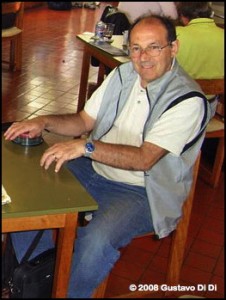
Humans had to learn to become acquainted with their surroundings from the very beginning, in order to survive. They also had to learn to distinguish the different natural phenomena evolving around them, and had to do so to anticipate them and take advantage of them. Man learnt playing… “rubbing
wood or striking stones, he found fire”, he was afraid and had fun at the same time. He learnt by observing “that a storm could knock down trees, that they would float on the water, and that they could hold him on the surface, too”. And it was playing that…”man could plunge into the water”, just for a while. But it was possible to get into another media and return to his own one!
With each experience he also learnt that PLAYING was a creative activity, it opened doors, and with games, other worlds could be created. And, moreover, that in those new worlds he was able to release himself from other hindrances.
Interacting with Nature, then, might have been one of the first liberating activity for human beings, as old as the same humanity and absolutely necessary, also, for their evolution and development -for it expanded their capacity for investigation and adventure.
Thus, man, born terrestrial, soon dared enter fish world -water-, and sailed, released from the restraints that it inflicted to him.
And in the air?… Birds’ world?
He soon learnt that air moves, that its strength -the wind- carries dust, sand, leaves, soil; it pokes fire, moves waters… but, he also learnt that birds do not travel only following the wind direction; even more, they don’t need it.
Playing with the wind strength, with heavier objects than the air and keeping certain control on them, was possible just 2,500 years ago, in Asia, as documented by kite historians who coincide in that its origin was a bit spiritual and a bit practical.
We have flown kites since then and till present times. Just for fun?… I don’t know. Why is it so fascinating to watch an object floating in the space, leaping, and seducing generations and generations from all cultures and ages?
Out of the multiple reasons that I’ve heard for justifying the flying activity until nowadays, during Internet age, I found that those based on “the emotions perceived while doing so”, as well as “the feeling of freedom produced by it”, are the most suggesting reasons.
Obviously, there’s also the kite building activity, but this is ultimately performed for flying them, to perceive those emotions and feelings, certainly intensified.It appears, then, that emotions and feelings -human constants- are what remained in the course of time, unchanged until present. And that those same reasons, would justify the pastime. However, we might find it dubious that there are just two main reasons. Could we say that there’s also
something magic in kite flying? Have you ever felt the need to ask yourselves what does it mean to do so, the very first time you flew a kite? Did you notice that that “something” initially felt when piloting a kite has been lost as time passed? Do we feel that it is an atavistic act? Or rather, that there’s something arcane in it, something that has still to be solved?…
It seems that Yes is the answer to all these questions. I’m convinced that there’s something deeper in this activity… But, what?
May be, * Somebody must have realized that “humans” move on a SURFACE. That is to say, in two dimensions. * And has also observed that fish and birds move on a SPACE, i.e., in three dimensions (3D). * Then, how can fish and birds do so but not man?
We can say that we have mimic fish with our own body and can move along the water surface and even dive. And we have also learnt that in those movements, something is moved (water, air), implying that there are forces and resistances involved. But, mimicking birds? Human beings feel an
existential envy about birds, because they can at times elude the force that trap us all, the Earth gravity, and can… move freely, in the Air, with no restriction.
THEY ARE MUCH MORE FREE… “And we wanted to fly”…
It was soon learnt that the big trick for flying was to take advantage of the air itself to stay upheld on space, somewhat like learning to float. But it is not easy to float on the air. You need an extraordinary effort and wings. Human beings could build small wing substitutes 25 centuries ago, and the necessary strength was supplied by WIND; we fly kites since then.
Many centuries passed before a technical answer was found, till it could be completely explained birds’ flight phenomena. Dedalo and his son Icaro’s dreams (Greek architecture who built Creta labyrinth) were left behind. Dedalo and Icaro were closed up in the labyrinth, from which they could escape only by flying. So Dedalo built wings for both of them and they managed to escape. But Icaro was younger, and he became so enthusiastic with flying that he flew higher than advisable, the sun separated the wings and he fell down and died. Dedalo, the father, managed to land and survived.
LESSON: 1°) From life labyrinths you always get out upwards. 2°) Man should fly as high as needed, though aware of where he should land.
It has not been long since human beings could somehow overcome the restraints on space movement in three dimensions. This was possible after learning kite design and building. Aerostat balloons had already done so by lightening the balloon. The important thing in that type of flight, helped by
machines that were heavier than air, was that “it no longer depended on wind”. We are still evolving in this respect, though it is still pending to solve the best dreamed Utopia: levitation, or at least, to be able a sort of autonomous moving in the air, as divers does in the water. Hang-gliding
and paragliding are close to the idea.
With the new kites, we have learnt that we can pilot them, fly them in the wind, and play with them, making them dance and turn somersaults within the wind frame. With new materials and innovative designs -no doubt- we have made a big qualitative jump; at present, we have reached an unimaginable
control level, as we can make them move ourselves on nearly overall surfaces.
At times, they even allow us to “dive” in the air space, like a plunge into the water. But that activity has always been limited by the existence or not of wind. So, the right moment to fly a kite is determined by Nature, if she doesn’t provide us the necessary wind to fly a kite (for absence or excess), we just have to wait…
The original dream for winning freedom is also restrained regarding “WHEN”, the time for the opportunity, the “CAIROS” time.
In late 2006, on occasion of the first Kite and Acrobatic Kite Patagonia International Festival, held in Comodoro Rivadavia, Chubut – Argentina, the brave BaToCo and Contraviento de Rosario team, together with John Barresi
and Dave Shattuck dared to fly their kites in the strong wind, surprising
a small though stoic public with their acrobatic routines. When winds reached and exceeded the 75 Km/hour, it was decided to suspend the exhibition. Waiting for better weather conditions, we moved to a basket gymnasium.
And it was there… right in front of us… that twenty five years of AEOLIAN dependency collapsed when John Barresi and Gustavo Di Si appeared with their “IN DOOR” flight.
Even though most of us present there theoretically knew about Indoor kite flying through videos, it was marvellous to watch it live. Looking at John flying to the rhythm of “Adiós Nonino” (Piazzola), surprising the public, who watched in silence the melancholic Revolution Indoor kite flying, -paying homage to the Argentines-, few of us, in fact, could manage not to move to tears on that day.
A bit later, more relaxed after the emotive demonstration, we watched John basket several times a delta kite into the basket ring, exhibiting “an absolute control of the distances and time”. It was then formed a natural learning clinic, and we were all able to make our attempt for Indoor piloting… and discovered that you needn’t wind for flying a kite. “Indoor” greatest contribution to our dream for gaining freedom is that you get released from “WHEN”. It doesn’t matter what may happen with the weather, we have won freedom for flying kites at any moment we choose, anywhere; also, we were free to choose the flight direction.
A really important technical contribution to kite history. Yet, I got the impression that there was something else in “Indoor” flying… There was something else I could not interpret. I have been reflecting on these new emotions since that day.
Here are some of them:
* It looks like if flying with wind were just as navigating downstream, swinging in the river flow but always downstream”.
* “When there’s no wind, kites would hurl to the ground”. They cannot float
in the air space, as “the trunks from knocked-down trees would do on the water”.
* “Flying kites with wind, is flying with crutches”? No, certainly not. * Then, it’s all about “changing a millenarian Paradigm”
* In a flight without wind, kites nearly FLOAT in the air”. * “They look more
like birds, which don’t need wind to fly, but rather air to lean on it”
Without wind pushing us, the pilot manufactures his own virtual wind and leans on the air. And this is the most interesting and new thing, “we are now LEANING on the air”. It is a new stage in the evolution of the kite flight dream.
The new talents acquired through Indoor are radical ones.
The big change in the history of the paradigm evolution, IS THAT YOU CAN FLY WITHOUT BEING AIDED BY WIND. We have won new unimaginable talents… “Because flying without wind IS FLYING”, are we closer to the Utopian initial goal?…
An Approach to the Acrobatic Flight Artist
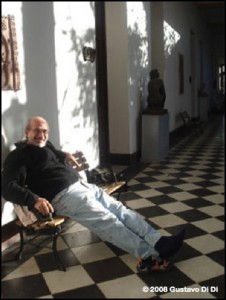
 With no wind, it is primarily important the technique that the pilot should acquire to place the kite in the space. Once it is acquired and dominated, new “expressive” needs arise. So, there will be actions intended to transmit the spectator the different states and emotions that the pilot is experiencing, to create “an artistic event or atmosphere”. Through 3D kite flying. The activity will point at the importance of how body evolves in the “expressive flight”. This flight differs from the others (recreation and competitive ones) because, even though the pilot needs a very depurated technique to place a kite in the space, in this case the emphasis will be put on the “expression and transmission”. Thus, the pilot has to include other artistic disciplines, namely, body expression, musical and plastic sense, among other… Once included, the pilot will be transformed into an “artist”.
With no wind, it is primarily important the technique that the pilot should acquire to place the kite in the space. Once it is acquired and dominated, new “expressive” needs arise. So, there will be actions intended to transmit the spectator the different states and emotions that the pilot is experiencing, to create “an artistic event or atmosphere”. Through 3D kite flying. The activity will point at the importance of how body evolves in the “expressive flight”. This flight differs from the others (recreation and competitive ones) because, even though the pilot needs a very depurated technique to place a kite in the space, in this case the emphasis will be put on the “expression and transmission”. Thus, the pilot has to include other artistic disciplines, namely, body expression, musical and plastic sense, among other… Once included, the pilot will be transformed into an “artist”.
The concepts to work will be the motor behaviour, with an expressive, communicational and aesthetic purpose, where the key issues are the body movement, the feeling expressed and the beauty perception. As a coherent combination of aesthetic principles, the musical sense is not absent. The
concepts of harmony, rhythm, melody, will encourage the pilot and spectator to live a uniform experience. We must manage to make the maneuver combination match the music and choreography, the correlation is fundamental. The pilot / artist will choose spinning, stopping, making curves,
straight flying, depending on what he wishes to transmit, according to his own “work”. The artwork is organized around a prevailing dynamic subject, from which the movement spreads throughout the whole piece area, in this case formed by: Surface = Air space and Movement that energizes it = The
Kite. These expressive qualities are the pilot’s expression means.
For the spectator, a kite in the space plus the pilot’s movement across the ground arouse visual tensions, speed and power, which -if duly harmonized- energize both spaces described, and they can be read either individually or in general, depending on where the attention is focused. They both have an expressive value, depending on where the visual emphasis is placed.
Therefore, the visual tensions, i.e., how the perception and impact of visual objects affect the spectator and how he/she perceives them, will depend on their previous learning. All the perceptions start through the eyes, and the spectator will group them by proximity, similarity, symmetry, shape and background, contour and level of expression to complete the information.
These formal properties, as they can be administered by the pilot, will allow living and transmitting different moods; for example, joy, fear, vitality, apathy, etc. It is interesting to point out the importance of the “interaction that should exist between the two grounds: the floor (pilot) and the air (kite)”. The pilot, depending on the shape, the height adopted and the speed employed to move along the floor low ground, will transmit-reflect such expression on the kite; through the umbilical cord (string) that joins them, like a “mirror”.
It is essential to pay attention to this symbiosis because, if this relationship is attained, the “first steps” towards the creation of a 3D artwork would be taken.
Gustavo Di Si
Buenos Aires, 2007

My friend Polo wrote some thoughts about, Why people fly kites “without wind”… In fact we get a new Paradigm. My friend Juan José Mosca wrote from artistic vision that involves some aspects to discover by the pilot.
Both visions interact in this system, and I am going to add the technical aspects. When you say: Indoor word, the majority of people think about covered places. But, fly of this manner suppose to lean kites on air, we have to consider the possibility to fly in uncovered places. This idea base on a new probable denomination, where the expression could be: Windless Indoor – Outdoor or simply Windless. Being the one of my specialties Multiple Sport Kite Flying, I would like to share my experience without Eolo services. (Have a look) I assure that this practice is going to improve our shape and MKF`s techniques.
What is relative wind? Real wind = Air moving. Relative wind = Air generate by pilot
How we can get Wind? The pilot movements make wind on kites by:
1. Arms movements
2. Body movements
3. Moving opposite from kite position
4. Combination of 3 above
If we apply the 4 points above, we can get our target indoor or outdoor.
I would like to explain on this manner:
* I have to walk or run? Fast or slowly? I have to move only backwards or it’s possible ahead and flank? It is possible to move ahead, backwards or the flank, the important thing is that we have to move opposed from kites generating the force necessary to fly our kites. From speed movements, I
would like to say that is inversely proportional to the technique applied. Best techniques, less effort to fly. Despite that, we can consider kite’s design and kite’s sail surface. Pilots that fly on a demonstration or competition, is different. In that case the use of the space, speed, harmonic conjunction, music, choreography, kite model and so forth is the key to win.
* Which is the best kite design?
I would like to say that, greater sail surface; greater sustentation but the kite flies slower and get less manoeuvrability. To the opposite, small kites. Therefore pilots will have to choose accordingly their fly’s style. In all cases we need to reach an optimal speed to take off and fly base on: aerodynamic, weight and sail surface.
* What contributes this kind of flight to us?
Now we are “the owner of Wind” it means that we have an additional freedom degree
* What kites I have to fly STD or specific design for windless indoor / outdoor?
Everything is possible with practicing. .
Nowadays I fly Y2 kite, from Gabriel Acosta’s designed, good for me and for MKF windless indoor / outdoor
 What we will feel at the beginning of practices? Probably we are going to feel dubbing. For example, it can appear “no wind kite’s ghosts” which say: Kites does not fly without wind… when we get two kites at the same time is reasonable think like that, because most of the people believe that to fly kites, is necessary a real Wind. Ok, so record in your mind: NO NEEDED on Windless
What we will feel at the beginning of practices? Probably we are going to feel dubbing. For example, it can appear “no wind kite’s ghosts” which say: Kites does not fly without wind… when we get two kites at the same time is reasonable think like that, because most of the people believe that to fly kites, is necessary a real Wind. Ok, so record in your mind: NO NEEDED on Windless
Indoor/Outdoor. If the kites fall down; that is because we did not surpass the old Paradigm. I mean, because we was waiting for Eolo`s aid. Adding a freedom degree to your fly you can fly whenever you want… so attention, break the “Paradigm” and do not kites…
Some keys:
1. The pilot manages his own speed and rate of fly.
2. The pilot have to feel the pressure of the relative wind into the sail
3. The pilot has to keep in motion.
4. The pilot manage the place without limits
5. The pilot have to move opposed from the kites.
6. The pilot has to maintain the control, trying to take the lines tight.
7. The pilot manages all the variables. Articles: “Multiple Sport Kite Flying – A
challenging and funny sport Parts I, II, III)
We can have a look to the following system: Situation = zero wind Pilot = new paradigm + artistic attitude + flying technique Kite = raw material and design
About Kites: Commonly the tuning comes from factories and we have to use it. Therefore, if we have difficult at the first steps to fly of that tuning, we can fit the bridles on a better angle of attack for takeoff. (Close the nose 5 mm at time). As soon as we get experience we will modify the tuning reaching our fly style.
 Length of lines: It depends on flying field and pilot style. My advice: 3 to 6 meters is OK.
Length of lines: It depends on flying field and pilot style. My advice: 3 to 6 meters is OK.
Using ballast: Some pilots use 2 or 4 grams of ballast giving kite’s inertia… Possible… To my experience it depend on kites design, pilot’s style and technique applied.
The handles: Handles are similar to MKF on classic fly; but just a little smaller and lighter.
 Learning to walk: It is necessary to harmonize the times between pilot and kites. You are wondering, why if we get the control of all the variables? The word “control”, indicates an inequality relation between Pilot and Kites. Is better to think “Pilots managing all variables”, establishing a single entity with our kites. Therefore to learn to walk, we can count 1 – 2 – 3 – 4 – rhythmically feeling the kite movements during fly.
Learning to walk: It is necessary to harmonize the times between pilot and kites. You are wondering, why if we get the control of all the variables? The word “control”, indicates an inequality relation between Pilot and Kites. Is better to think “Pilots managing all variables”, establishing a single entity with our kites. Therefore to learn to walk, we can count 1 – 2 – 3 – 4 – rhythmically feeling the kite movements during fly.
When we fly Two at the same time? What happen? From my experience, when we fly two, the kites fly separately one to another, forming an angle respect to our position. This situation will cause different sail pressure from the perpendicular angles. (Example: like single kite flying). In order to compensate, we have move a little faster than when we fly only one kite. On 360º flying, another factor influences are the acceleration and centrifugal force. (Think about Hammer launching in Athletics sport – similar image). OK?
The draw below was made by Polo Madueño to explain the 360º sphere physical forces interaction.
Starting maneuvers:
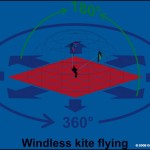 The target is to try to fly 2 kites windless indoor / outdoor at the same time with independent control. Therefore the first step is trying to do it with one kite. Similar to when we began to fly MKF on standard way. Just when we gain experience and practicing we will be ready to fly two at the same time
The target is to try to fly 2 kites windless indoor / outdoor at the same time with independent control. Therefore the first step is trying to do it with one kite. Similar to when we began to fly MKF on standard way. Just when we gain experience and practicing we will be ready to fly two at the same time
Basic Maneuvers:
1, Take off 2, Landing 3, Flying 360º 4, Turn
Take off: We can get some alternatives for take off and all of them work perfectly for MKF. First step: I recommend lying kites on a support behind them. Then take the handles on keeping the lines tight. Walking backwards-generating lift to take off. Wow! We are flying! Second step: we can
practice the same exercise, now, placing kites on the ground and taking off from there. We can walk straight or 360º (see Forward 360º maneuvers)
Landing: We have to walk forward towards the kite but in slow motion speed. On that way we have to be careful, because if we move so fast, the kites will fall down abruptly to the floor. I recommend landing in two wing tips. Move slowly, in time of kites keeping the lines tight and managing the kite all the time. That is techniques are because we are the “owner of relative wind”.
Flying 360º Take off accordingly as I described above, then we turned the kite towards a side (Example towards the right side) In this case the position of arms and handles are the key to obtain sustentation. Therefore we have turned our wrists giving them the angle necessary to fly. I should recommend turning the body just a little to be more comfortable during the flight, maintaining the
eyes fixed on kites. Walk in 360º and fly.
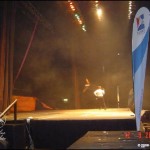 Turn: I should recommend do the turns not very closed. At the beginning having height distance to the floor reaching enough space. (Remember that we could be flying with 3 meters line length) It is very normal during turns that we forget to walk. If so, the kite loses sustentation doing the wing tips touches the ground. In order to solve this, we have to give additional height and speed, walking faster. Practice a lot and gain experience; you are going to feel great…
Turn: I should recommend do the turns not very closed. At the beginning having height distance to the floor reaching enough space. (Remember that we could be flying with 3 meters line length) It is very normal during turns that we forget to walk. If so, the kite loses sustentation doing the wing tips touches the ground. In order to solve this, we have to give additional height and speed, walking faster. Practice a lot and gain experience; you are going to feel great…
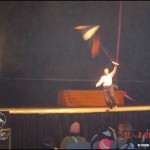 With Waist: One of the possibilities to fly MKF is with waist. The question is: Is it possible without wind? Well… Watch this video: On Google Did you watch it? … my kite, fixed on my waist, shakes its nose according to my movements. So if the music has much ritm, is OK, it has an advantage because additional movements seems that the kite dances “in Time of music’. But, what would be happen on a smooth music? Maybe not very aesthetic to see our kite shakes its nose like a colt. To avoid it, we can fix the kite on chest similar to Carl Bragiel style … Test it and see what happen!
With Waist: One of the possibilities to fly MKF is with waist. The question is: Is it possible without wind? Well… Watch this video: On Google Did you watch it? … my kite, fixed on my waist, shakes its nose according to my movements. So if the music has much ritm, is OK, it has an advantage because additional movements seems that the kite dances “in Time of music’. But, what would be happen on a smooth music? Maybe not very aesthetic to see our kite shakes its nose like a colt. To avoid it, we can fix the kite on chest similar to Carl Bragiel style … Test it and see what happen!
Oh! Yes …I almost forgot….you have to be concentrated very well… I assure that in a short time you get a good shape. Eventually the question is: Is it possible to fly MKF Windless Indoor / Outdoor with 3 at the same time?…
Multiple Sport Kite Flying Windless Indoor / Outdoor is one of the most challenging and funny sports that always puts on approval pilot’s skills.
I hope that this technical article is going to be a useful guide to everybody who wants to practice.
 http://www.elalmadelpiloto.com.ar
http://www.elalmadelpiloto.com.ar
Best Wishes,
Gustavo Di Si



